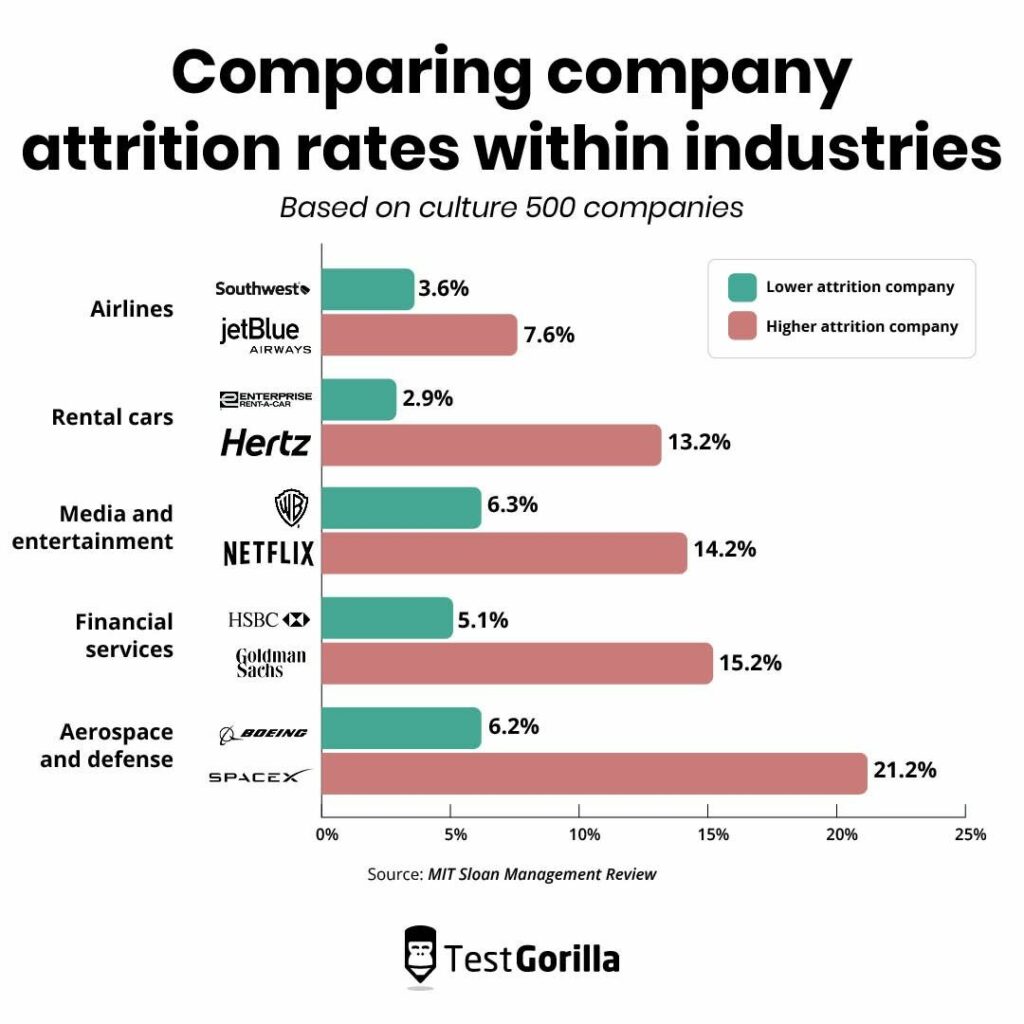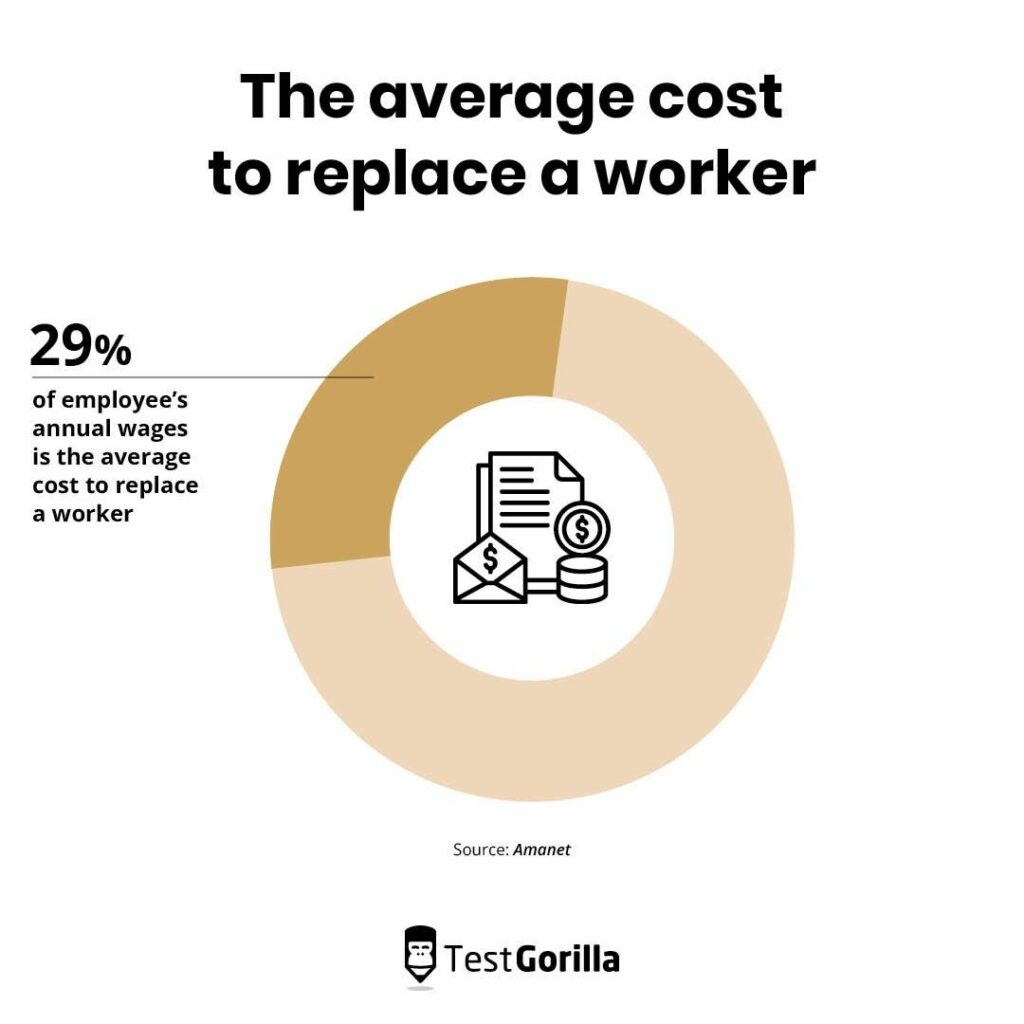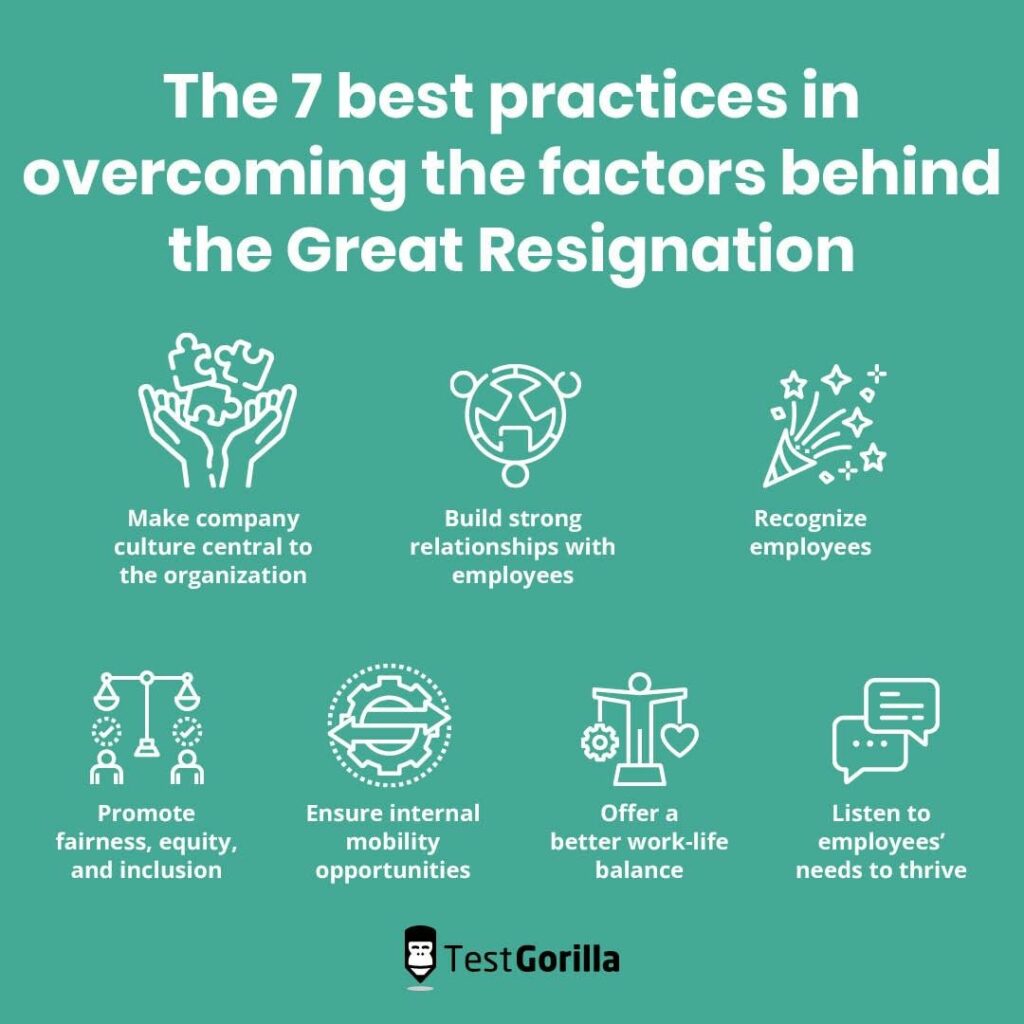Toxic culture is driving the Great Resignation: What can you do about it in 2023?
The Great Resignation is a real and persistent issue.
There’s a disconnect between employer and candidate motivation, more people than ever are quitting jobs to find companies that accommodate them better, and the labor market is highly competitive.
It started with the pandemic, but we’re getting further from that peak lockdown time, and the record turnover rates aren’t improving.
So what’s really behind this issue? How can you overcome a global-scale problem?
Prepare for a Scooby-Doo-style face reveal because both answers lie in this fact:
Toxic culture is driving the Great Resignation.
While the Great Resignation itself isn’t in your control, you can change the circumstances, practices, and culture driving high turnover and drastically improve your company’s status quo.
But let’s unpack it all from the beginning:
What else contributes to the Great Resignation?
How long will it last?
What can organizations do to combat it?
Table of contents
The drivers of the Great Resignation: A toxic culture is #1
A record number of people resigned from their jobs in 2021. The Great Resignation in 2023 keeps rolling full steam ahead.
According to an MIT Sloan Management Review study that analyzed 34 million online employee profiles, the attrition rates from layoffs, resignations, and retirements over this period vary considerably between different industries.
Interestingly, even within the same industry, companies have dramatically different employee attrition levels:
This is great news!
The contrast among companies of the same industry shows how much the way we run our organizations affects our experiences and outcomes.
Yes, the Great Resignation is a global problem. But clearly, there are ways you can control its hold on your company by attacking its drivers inside your walls.
So what’s the real reason everyone is quitting? These are the five most often cited reasons, in ascending order:
Poor response (especially during COVID-19) and disregard for employee well-being: Employees, particularly women, are more likely to quit if they feel like companies don’t care about their overall well-being.
Lack of employee appreciation: High performers are most likely to be upset by a lack of appreciation or recognition, which means that organizations stand to lose their star employees.
High levels of innovation: Higher levels of innovation often mean that employees have to stay longer, work harder, endure more stress, and fly closer to burnout than their peers in businesses with a slower pace, and the poor work-life balance makes them more likely to leave.
Job insecurity and reorganization: If a company struggles, reorganizations and layoffs can happen. Employees whose outlook on the company’s future is negative are more likely to run for their lives in search of a more stable job.
Toxic corporate culture is the #1 reason by far: A failure to facilitate diversity, equity, and inclusion, a disregard for employee well-being, and tolerance of unethical behavior make employees feel disrespected and distrustful of their colleagues
As you can see, all drivers of the Great Resignation contribute to and tie into that biggest culprit of all: toxic culture.
We’re talking about a culture where employees feel undervalued, overworked, or unsupported.
A predictor of toxicity is when employees dread coming to the office. It can be because they don’t trust their colleagues, they’re tired of heavy workloads and not being recognized for it, or they’re experiencing some other symptom of a toxic workplace.
It makes sense that people in this situation would be looking for other opportunities, right?
Luckily, there’s a lot management and HR can do about these factors to lower your attrition levels and make your organization a great place to work right now.
But do you have to? Hypothetically, if you wanted to do the bare minimum and wait out the Great Resignation, how much would you have to wait until it resolves itself?
Is the Great Resignation still an issue in 2023?
Now we come to the burning question on everyone’s minds: “How long will the Great Resignation last?”
The Great Resignation is an ongoing debate. Some people think that employees will stop quitting so frequently now that the economy has taken a turn for the worse.
If so, can we stop worrying about our workforce leaving us and get back to business as usual?
Here’s the thing: If you look at the drivers of the Great Resignation, it’s clear that a solid part of the root problem comes from us – the way we run businesses.
The Great Resignation was nudged into hyperspeed by the pandemic. Its symptoms and consequences have grown to a global scale and made it look like its own external event.
By now, we know that that’s not the end of the story because turnover rates are still on the rise going into 2023.
The Great Resignation is still going on because our policies and cultures perpetuate it, and it’ll last until we change our approach.
This important fact can change the way we think about the problem.
The Great Resignation helped to show us what was wrong with our organizations. If we don’t fix these issues, these underlying problems will still drive turnover and unnecessary costs for companies, even if the record resignations subside.
To give you an idea, many studies put the price of employee turnover at 29% to several times the annual salary for a single employee.[1]
Today, if your employees earn an average of $95,000 per year, losing three employees could cost you $342,000 a year to recruit and train new talent and get the productivity levels back up.
But it’s not all bad news.
According to Gallup’s recent study, 52% of respondents (employees who quit) say their managers could have done something to retain them_._
This brings us to our main point.
No matter how long the Great Resignation sticks around, the truth is:
Losing even one employee is expensive and a waste if you could have prevented it
More often than not, you can prevent it
So let’s see how you can turn it around and retain your employees longer, Great Resignation or not.
The real issue in 2023 and beyond: Overcoming the factors behind the Great Resignation
This is the key learning point – as employers and HR leaders – need to take a cold, hard look at our organizations and make them better places to work.
That’s the key to attracting top talent, retaining our employees, and motivating a highly productive workforce.
How?
Here are some proven ideas to tackle the root problems.
The summary of 7 best practices
We’ll get into the details in a second, but you can use this table as a reference point or a quick breakdown.
Now let’s elaborate on each point.
1. Make your company culture central to your organization
Everyone needs to live and demonstrate your company values to create a healthy and productive community from the top down.
You want to cultivate an environment where everyone feels safe and appreciated – a place where they can belong.
It’s important both for employee well-being and satisfaction and company productivity. However, it takes conscious effort, especially for remote workers who never even get to see their colleagues.
Here are some elements of a positive culture to incorporate:
Radical candor: Communicating directly but with kindness and empathy
Conflict management: Civilized discussions and constructive solutions
Learning and growth: Learning together and from each other all the time
Teamwork: Sharing the load, jumping in to help one another
The trick is to tie these factors into your recognition and promotion metrics.
By doing that, you give these values weight and send a message that they’re just as important to you as employees’ hard skills and performance.
Recognition and promotions are more tangible and important to employees, so use them as incentives to encourage positive behavior.
Similarly, discourage toxic behavior any time you see it.
It’s important for employees to know you’ve got their backs when things get ugly. Promoting a disrespectful colleague disappoints good employees and turns them away from you.
Loyalty and trust go two ways. As the leader, you need to be the one to take the first step.
The more employees follow and model the company values, the more these values become your company’s norm, and your company becomes a healthy place to work.
2. Build strong relationships with employees and ensure they feel connected
A sense of belonging is crucial for employees and directly impacts your business:
Increases job performance by 56%
Reduces turnover risk by 50%
Decreases employee sick days by 75%
But a lot of your employees don’t feel like they belong by default, especially remote workers.
Opportunities to connect don’t come by so often when you’re not in the office and bumping into coworkers every day.
Use these ideas to build stronger relationships with your employees and help them feel connected:
Show them you trust them to do their jobs and don’t micromanage them.
Have regular 1:1 meetings to see how they’re doing and chat; once a month or so is a good start.
Provide opportunities for them to connect with each other, like group chats, calls, and even virtual parties.
Let them know that you’ve got their backs and don’t tolerate anyone disrespecting them.
Help them achieve their goals any way you can and celebrate their wins.
Trust doesn’t happen overnight, so be patient and keep showing up. Eventually, your employees will meet you there.
3. Recognize your employees
Showing your high performers you see and value their work is key to maintaining their motivation and making them want to stick around.
Meanwhile, if anyone is struggling to perform at that high level, they could use empathy, support, and a chance to learn – from other people’s success stories or examples and from mentoring.
It’s easy to like people who do well, but it’s a good idea to recognize your employees’ inherent value even on their off days. It helps them bounce back quickly and increases company loyalty.
You can show employee appreciation in the following ways:
Peer to peer recognition (and manager to team)
Informally, by thanking them for their hard work and letting them choose which projects to work on next if possible
Financially, by giving them performance-based rewards
Via shout-outs for high performance and support when needed
Social events dedicated to recognizing workers
You can use the 5 languages of appreciation to ensure the sentiment is getting across and your employees actually feel that you care.
Study which language suits them best.
For example, giving them an honest and specific compliment is a great way to show appreciation to an employee who responds well to words of affirmation. A 1:1 video catch-up might mean more to somebody who likes quality time.
Just remember to be fair and show appreciation fairly to all employees, so nobody feels left out.
4. Promote diversity, equity, and inclusion
Prioritize diversity, equity, and inclusion both in your hiring practices and the day-to-day life in the company.
Why?
Recruiting candidates from a wide range of backgrounds enriches your workforce with new ideas and potentially changes the lives of some applicants.
For instance, those with a criminal record are often excluded across the board and don’t have the chance to rejoin the workforce and healthily reintegrate into society.
Given the opportunity, they can turn out to be some of the most motivated and engaged employees you could hire because they’re grateful for the chance to show their worth and prove you right to trust them.
Opening your doors to applicants from marginalized or alternative backgrounds widens your talent pool. It helps you build a diverse and innovative workforce.
In turn, such candidates are more likely to model fairness and inclusion on their own accord because they understand what it’s like on the other side of these values.
They can help create a workplace environment that feels safe and welcoming to candidates of all genders, ethnicities, sexualities, and walks of life.
So, where do you begin putting these values into practice?
During hiring, incorporate these measures to welcome all candidates:
Method | How to incorporate it |
1. Skills-based assessments | Use ; Recruit for skills, personalities, and potential; Lose the CV and other sheer formalities |
2. | Be open to candidates with criminal records; Don’t disqualify applicants with criminal records across the board |
3. Inclusive language | Use gender-neutral terms and pronouns in your job ads; Avoid terms like “ninja” or “wizard” |
4. Contain interviewer bias | Run structured interviews; Have a hiring panel to reduce individual personal bias |
Once your workforce becomes more varied, inclusion and diversity will naturally prevail in the company culture and signal to new candidates that this is the place to work.
5. Ensure internal mobility opportunities (upwards and lateral)
A LinkedIn study found that innovative companies that excel at internal mobility achieve almost two times the retention rate of those that don’t.
High internal mobility improves employee retention, engagement, and agility while reducing hiring costs and time.
So what is internal mobility?
Internal mobility opportunities include mentorships, shadowing, and new jobs where employees can gain new skills and progress in their careers within the organization.
In other words, employees don’t have to leave if they want to move forward.
Moving upwards means getting a promotion to a more specialized or senior role in the same line of work, while lateral career opportunities incorporate skills and responsibilities of other roles.
Providing both types of mobility opportunities helps you avoid skills gaps and grow a versatile, adaptable workforce that can stand the test of time.
6. Offer a better work-life balance
Flexible working hours, remote work, and better non traditional benefits all contribute to a healthy work-life balance.
This is important for both hiring and retaining employees.
While some workers prefer predictable schedules, having a flexible work policy and being known for it attracts a much wider talent pool that includes:
Working parents who need flexible hours
International candidates who can work remotely
People with disabilities who need accommodations
Millennials and Gen Z who prioritize flexibility
Having all these options means you can build a workforce of the best performers and not have to resort to the local C-team.
But no matter who you hire, ensuring they’re having enough rest, fun, and family time in addition to financial security is crucial to retaining them.
Nobody should be working in an environment where they have to neglect their health or happiness.
Promoting proper work-life balance combats the toxic culture of overworking and helps employees live healthy and fulfilled lives. This helps create a work environment where people want to stay because it’s a positive in their lives rather than an experience they need to recover from.
7. Listen to your employees and what they need to thrive
Be attentive to employees’ performance and general well-being.
It’s not just about providing perks like healthcare. It’s about making sure they know you’re in their corner and want to work as a team to help them when they need it.
It’s not all about getting their 100% all the time – sometimes even star employees need to prioritize another aspect of their lives, or they’re just tired and need a break. And that’s perfectly okay.
It’s better for all parties, both short-term and long-term, if you support workers and make space for their needs because they’ll eventually come back refreshed and on top of their game.
Otherwise, they might have to drop out for good.
Showing you care about your team’s well-being doesn’t have to mean having emotionally draining talks each week.
Simply weave it into your day-to-day communication – ask how their day is going and how they’re feeling.
Keep reminding them to ask if they need anything, and be responsive when they do ask for help.
They’ll remember it.
Toxic culture is driving the Great Resignation: Let’s work on it
The Great Resignation is the global elephant in the room that you can’t move. But toxic work culture?
Now that you can work on.
Knowing the root issue means you can start taking steps to remedy it and combat the Great Resignation.
Company culture starts with leadership.
It’s on you to establish a culture where people support each other, learn together, celebrate peers’ wins, and contribute to a healthy and productive work environment.
Use our Enneagram test to find candidates who will push your ethos and challenge your team in positive ways.
You’re on the right track to instigate change. Check out even more ways to foster a positive workplace culture.
Source
Morrison, Carol. (January 24, 2019). “Retention Before the Fact”. American Management Association. Retrieved January 17, 2023. https://www.amanet.org/articles/retention-before-the-fact/#:~:text=The%20U.S,Salary.com%2C%202006)
Related posts
You've scrolled this far
Why not try TestGorilla for free, and see what happens when you put skills first.
Latest posts
The best advice on pre-employment testing, in your inbox.
No spam. Unsubscribe at any time.

Hire the best. No bias. No stress.
Our screening tests identify the best candidates and make your hiring decisions faster, easier, and bias-free.
Free resources
This checklist covers key features you should look for when choosing a skills testing platform
This resource will help you develop an onboarding checklist for new hires.
How to assess your candidates' attention to detail.
Learn how to get human resources certified through HRCI or SHRM.
Learn how you can improve the level of talent at your company.
Learn how CapitalT reduced hiring bias with online skills assessments.
Learn how to make the resume process more efficient and more effective.
Improve your hiring strategy with these 7 critical recruitment metrics.
Learn how Sukhi decreased time spent reviewing resumes by 83%!
Hire more efficiently with these hacks that 99% of recruiters aren't using.
Make a business case for diversity and inclusion initiatives with this data.




















